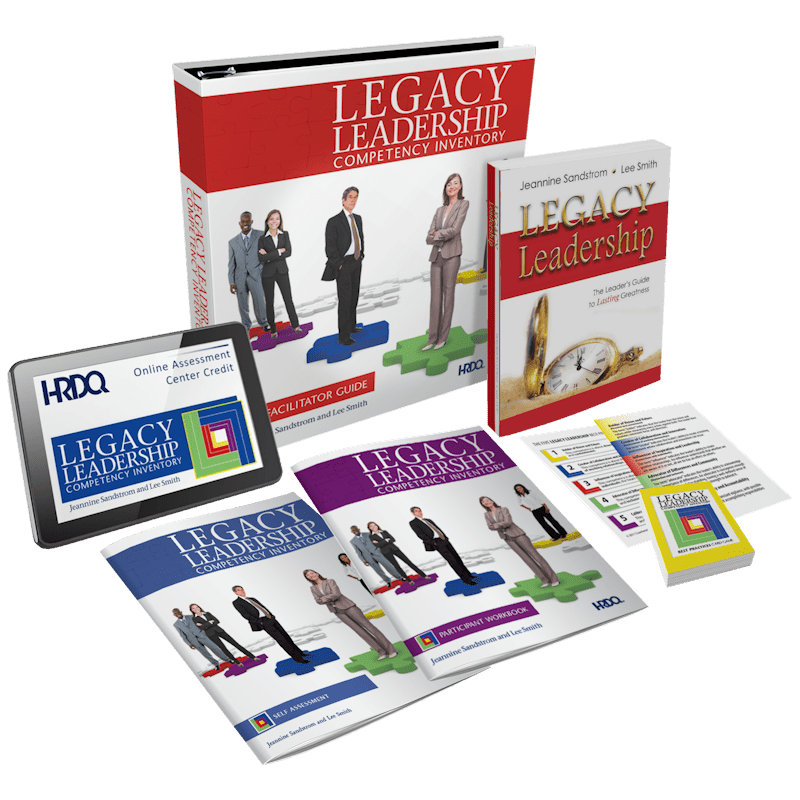Training tools for developing great people skills.

Legacy Leadership: What Is It and How Does the Model Work?
Have you ever considered the mark you'll leave as a leader? The deeds, decisions, and drive you bring to the table all add to what I call Legacy Leadership – a model that stretches beyond the usual leadership boundaries.
Today, it's about the "echo" that will remain there once you've moved on. The job is to create something wide-reaching and lasting.
But building a solid legacy doesn't happen overnight; it requires steady commitment and hard work.
Let's talk about the fascinating Legacy Leadership model then, shall we?

- Develops leadership skills
- Enhances team effectiveness
- Cultivates communication skills
Table of Contents
What Is the Legacy Leadership Model?
Getting to know the main points of the Legacy Leadership Model can give you real insight into what makes a legacy leader last.
First up is the Holder of Vision and Values. This is about how leaders should take an active part in sticking to and showing off the organization's important vision and values. It's about doing these values, both talking about them and proving that leadership leans more on action.
Next is Change Through Inspiration and Leadership. This part tells leaders to make their teams more adaptable to organizational changes. Interesting, isn't it? Effective communication is essential here. It helps the team stay flexible and resilient without losing the central vision and values.

Then there's Value Differences and Build Community, which emphasizes the value of diversity and inclusivity in leadership. Legacy leaders take diversity programs a step further: they use programs that really work to promote understanding and unity in different teams.
Fourth, Strengthen Responsibility and Accountability makes it clear that leaders must be responsible and accountable in their behavior. Think about it: the leader sets the tone, right? By leading by example, they encourage accountability in their team, too.
Last but not least is Mold Your Leadership Legacy. This reminds leaders to think about their long-term legacy. With tools like the Legacy Leadership Competency Inventory, leaders can spot their strong points and areas to work on for effective growth.
See? Each point in the Legacy Leadership Model plays a massive part in building a strong leadership legacy. It tells leaders to think big – to think about their immediate change and the long-term effects, too. When leaders start to follow these rules, they're setting themselves up for a long-lasting legacy – one that'll change the lives and careers of the people who come after them for years to come. It's something worth considering!
Holder of Vision and Values
Legacy Leadership revolves around you, the leader, staying accountable; think, I hold the organization's central vision and values. I carry a heap of responsibilities; the characteristics aren't light either.
As a leader, my part says, "Define outcomes that are clear; make them compelling!" I drum up enthusiasm for the team by bringing attention to the changes that could come our way.
Shouldn't my actions match up with the values I say aloud? A real leader like me can measure my authenticity by lining up my deeds with my words. When my words match my actions, it shapes up the organization's principles – useful tools for making decisions; they shape behavior, too!

Personally, I'm the go-getter leader. I'm always finding ways to weave the vision and values into the organization's very fabric. As a mentor, I give these basic beliefs to my team. I want to see these principles produce results. Yes, even when I've handed the baton to the next leader.
But doesn't maintaining vision and values need flexibility? I'm strong, and change doesn't scare me. I think being able to clear obstacles and handle ups and downs without straying from really important principles is necessary. I cling to the mission and face up to challenges; these are qualities that can't be replaced.
I think about my part like this: I'm making a lasting change. I'm focused on the legacy. Am I driven to lay down a solid foundation, avoiding the temptation for easy victories? That feels right – it means lasting success. The art of creating a sturdy, value-driven culture weighs a lot – they rely on my skill to voice and display my vision and values. I want to instill these beliefs in others. Would you agree that my leadership style left a lasting mark during my term? It helps shape the future direction of the organization.
Change through Inspiration and Leadership
Understanding what you're good at and making it work for you is essential to being a successful leader. A leader who really gets themselves can spot what makes them special and then use that to make a difference. Take the leader who's a great talker – the leader uses it to establish strong team bonds, lift morale, and make sure people feel the change. It shows others how they can do well with their own skills, too.
True leadership? It sets an example for others to follow: acting and thinking in ways they can look up to. Leaders walk the talk; pro-status doesn't matter as much as personal values. They have honesty, decency, and empathy perfected. Notice how a leader never hesitates to spotlight team achievements and is always right in the mix when decisions are made – actions that inspire their team to look for the same ideals.
Leaders who want to leave a lasting mark are committed to making a difference. How do they fuel this ambition? By syncing their actions with their core values and job. It's like tossing a stone in a pond – the ripple effect is both in their immediate circle and touching even those yet-to-come.

The thing about these legacy-minded leaders is that they get started early on their pro path, not leaving it until the twilight of their tenure. They lay out clear goals for the future and align those with their leading part. Always going for substantial change, these leaders infuse others with the same inspiration to follow in their footsteps.
Legacy leadership comes down to making a difference that lasts and guiding others long after you've moved on. It will spawn a line of influential leaders but ensure your change keeps making waves long after you've handed over the reins.
Value Differences and Build Community
A leader should aim for a zone that treats everyone equally and takes a stand against prejudice. Change always comes with a pinch of skepticism, right? The idea of diversity and inclusivity might cause misunderstandings instead of nurturing unity among employees.
What about these doubters – should we take them on? In my book, diversity in your organization has many uses and benefits. It ignites creativity, boosts engagement, gives us a competitive edge, and mirrors the many faces of our clients. Do we consider the added benefits of another group having an expansive perspective and fresh ideas? Isn't it a thrill to upset the status quo? A work culture covering multiple perspectives supports an environment where employees feel recognized, cherished, and relaxed. Here's a point to wonder: happy teams and a low rate of staff leaving. These aren't the main goals of creating diversity, but they boost output directly.
Think about these Legacy Leaders – pillars of the community. Rather than ignore differences, they ensure equal opportunities; they prompt an open exchange of ideas and mutual respect. Who doesn't want their voice to matter? Everyone's input plays a massive part in making a supportive, positive work culture. This sort of environment treasures individuality while also building unity within the team.

Building belonging within a business can be challenging; it requires effective communication, building relationships, and alignment on shared objectives. I suggest sculpting a shared vision through transparent communication; it's a tried and true method for making a team feel more like a family. Regular chats with teammates strengthen relationships and create a workspace with mutual respect and teamwork. Reaching for shared goals holds a powerful change in team spirit, shifting the focus from "I" to "we." Doesn't that sound much more exciting than working alone?
Legacy Leaders don't settle for standard diversity training – they go for the gold, focusing on practical integration and engagement programs. Establishing help groups, supporting cross-cultural mentorship, and pitching projects to different crews for better understanding are all part of their game plans. What happens when employees of diverse backgrounds work toward shared missions? The result is like magic – cultural awareness skyrockets, and the unity in diversity dream becomes tangible.
Strengthen Responsibility and Accountability
Leaders like me set the tone by focusing on the change in our actions and accepting responsibility for our team. It's a big part of my job to create an environment where the team sees mistakes as lessons and cheers on victories. You should know that when leaders own their mistakes, the team also feels fine admitting theirs. So what's the payoff? You get a mindset-boosting environment that helps people grow!
I'm all for "do more, talk less" – that's my mantra and the mantra of others who value accountability. You won't find these leaders wasting time – oh no, we stick to what we say, meet our deadlines, and carefully consider the results of the decisions we make. Is there any leader who shows accountability? That's a quick way to earn respect and trust from the team, and you can bet others will start copying that behavior.

Let's get one thing clear: there's no sitting on the sidelines when it comes to creating accountability in an organization; leaders have to roll up their sleeves and get stuck in the work. So, here's a question: what kind of message are you getting when leaders openly take on the blame for what they do? Sure packs a punch in the team's understanding of what's acceptable at work – in a good way – don't you think?
Can you see it? Responsibility and accountability spread throughout the organization like the ripple effect on a calm pond. Whose job is it to start those ripples? Leaders who take charge. It's me and others like me who lay down the rules and reinforce how important it is to take responsibility and stick to commitments.
What Alternatives Are There to Legacy Leadership?
An important shift from the traditional models, distributed leadership finds its home in enterprises. It's a method that gives power to the employees who know their things technically; this cultivates a cooperative space built on trust and the crew's integrity and know-how. So, we're talking about a different form of leadership compared to the usual top-down technique.
Then there's Agile leadership, a technique increasingly making its rounds in the business scene. Swift decision-making and flexibility define this leadership style, which is a real benefit during unpredictable times. As firms start to like a more flat structure, focusing on the tasks specific to the project, there's no doubt the need for Agile leaders improves.
At the same time, the business world is seeing more collaborative leadership. It's in nurturing shared goals and common wins – individual success gets pushed to the sideline. So, it pushes everyone to see the big picture, creating teamwork and knocking down any hierarchical walls; rather than focusing on individual pieces, collaborative leadership hones in on the whole thing.

On a different note, sustainable leadership is making waves, especially in businesses that aren't shy about pulling out their Diversity, Equity, and Inclusion (DE&I) data tools. But I'm talking about having variety on the team; these leaders dig deeper. How about the potential long-term effects of decisions on their employees, customers, and even the environment? These guys take a keen look at sticking to ethical factors and sustainable practices.
Finally, we have Legacy Leadership, which integrates all the various facets of leadership development into one comprehensive model. This isn't about mass-producing products or making a profit – it's about building up individuals. Shared learning experiences fuel this technique, and it triggers a chain reaction in training more leaders.
So, where does that leave you? Your leadership style could be in for a change, and it could work wonders in changing those around you and shaping the future of your organization. Legacy leaders who make it big make sure their values stick around long after they've stepped down. Their change continues to resonate – that's the real heart of Legacy Leadership.
How to Mold Your Leadership Legacy?
These are the kinds of leaders who invest in their team's growth and value each person's unique contribution.
It's important to remember that making a legacy isn't a one-off thing; it's an ongoing, round-the-clock commitment. You shape your leadership legacy by embodying your values, nurturing growth, valuing diversity, and constantly striving to make progress. Part of this ongoing process includes the Legacy Leadership Competency Inventory (LLCI), a practical, methodical tool to help leaders find their strengths, recognize potential roadblocks, and evolve into leaders leaving a lasting imprint on their organization's culture.

Your mission, if you choose to accept it, is pretty clear: imagine a legacy that holds its own, immune to the ebb and flow of time and change. In doing so, you integrate your goals and principles into your organization's future; basically, this is what it means to be a true Legacy Leader!

About our author
Bradford R. Glaser











![[Guide] Mapping the Path of Erikson's Developmental Process](http://hrdqstore.com/cdn/shop/articles/Eriksons_Developmental_Process.jpg?v=1708737452&width=180)












![[Guide] What Is Vroom's Expectancy Theory of Motivation?](http://hrdqstore.com/cdn/shop/articles/A_Motivated_Employee.jpg?v=1702076987&width=180)




















![[Guide] What Are The Different Employee Onboarding Phases? - HRDQ](http://hrdqstore.com/cdn/shop/articles/guide-what-are-the-different-employee-onboarding-phases-549815.jpg?v=1688797514&width=180)








Leave a comment